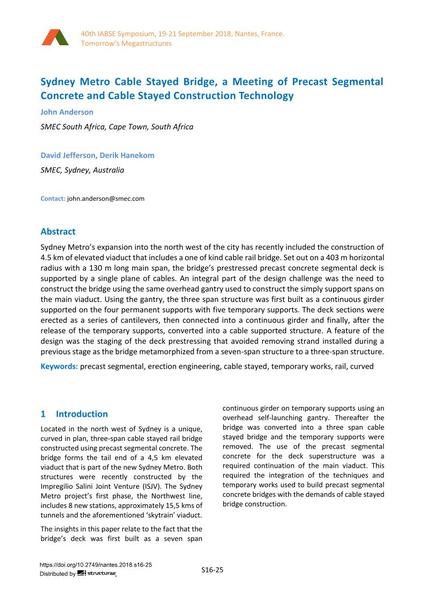Sydney Metro Cable Stayed Bridge, a Meeting of Precast Segmental Concrete and Cable Stayed Construction Technology

|
|
|||||||||||
Bibliografische Angaben
| Autor(en): |
John Anderson
(SMEC South Africa, Cape Town, South Africa)
David Jefferson (SMEC, Sydney, Australia) Derik Hanekom (SMEC, Sydney, Australia) |
||||
|---|---|---|---|---|---|
| Medium: | Tagungsbeitrag | ||||
| Sprache(n): | Englisch | ||||
| Tagung: | IABSE Symposium: Tomorrow’s Megastructures, Nantes, France, 19-21 September 2018 | ||||
| Veröffentlicht in: | IABSE Symposium Nantes 2018 | ||||
|
|||||
| Seite(n): | S16-25 | ||||
| Anzahl der Seiten (im PDF): | 8 | ||||
| DOI: | 10.2749/nantes.2018.s16-25 | ||||
| Abstrakt: |
Sydney Metro’s expansion into the north west of the city has recently included the construction of 4.5 km of elevated viaduct that includes a one of kind cable rail bridge. Set out on a 403 m horizontal radius with a 130 m long main span, the bridge’s prestressed precast concrete segmental deck is supported by a single plane of cables. An integral part of the design challenge was the need to construct the bridge using the same overhead gantry used to construct the simply support spans on the main viaduct. Using the gantry, the three span structure was first built as a continuous girder supported on the four permanent supports with five temporary supports. The deck sections were erected as a series of cantilevers, then connected into a continuous girder and finally, after the release of the temporary supports, converted into a cable supported structure. A feature of the design was the staging of the deck prestressing that avoided removing strand installed during a previous stage as the bridge metamorphized from a seven-span structure to a three-span structure. |
||||
| Stichwörter: |
Schiene Baubehelfe
|
||||

